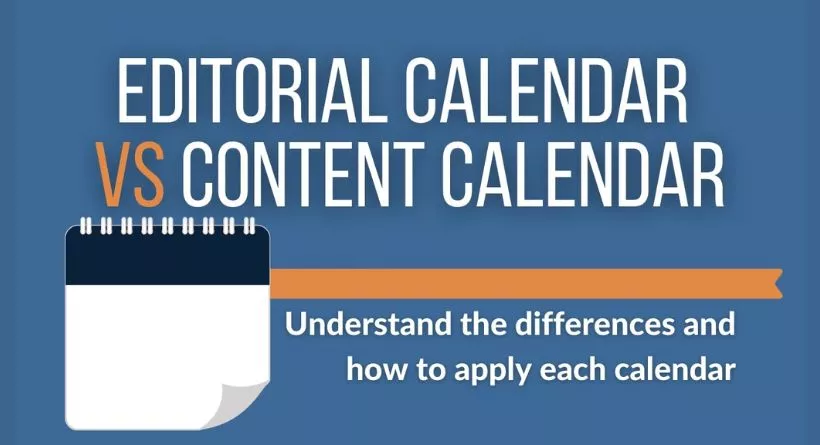In the digital age, capturing people’s attention is a challenging task for businesses due to intense competition. To overcome this hurdle, companies are adopting a multichannel marketing strategy, which involves publishing content across various platforms such as blog posts, TikTok videos, podcasts, and more. To make your target audience aware of your brand, you must follow a similar approach and be omnipresent. However, managing multiple marketing channels while creating an enormous amount of content can be overwhelming. Therefore, creating an editorial calendar can help you stay organized and streamline your content creation process. In this article, we will guide you through the steps of creating an editorial calendar to ensure that your content marketing efforts remain on track and effective.
What is an Editorial Calendar?
When developing a well-planned content marketing strategy that upholds consistency and builds your brand image across all marketing platforms, an editorial calendar is an essential piece of planning software to have at your disposal. The practice of using editorial calendars in conventional forms of publication, such as magazines and newspapers, allowed editors to plan out and organize the material that would appear in forthcoming issues. An editorial calendar is an essential piece of equipment for content marketing in the modern, digital age. Individual content authors as well as multinational corporations make use of this valuable resource. An editorial calendar allows you to organize and manage your content across numerous channels for a whole year since it gives you a high-level picture of your content strategy. This overview may be found in the calendar. In addition, it assists you in establishing a sustainable pace for releasing new material on each platform, which is crucial for success, and in maintaining consistency, which is also essential for success. An editorial calendar helps to build your brand image by ensuring that a consistent brand message is communicated across all marketing platforms. As a result, an editorial calendar is a great tool for the content marketing efforts that you put forward.
It is possible that you may not need an editorial schedule if you are just posting material as a pastime and not with the purpose of constructing or expanding an audience. Yet, if your objective is to grow or increase your audience as well as monetize your content, an editorial calendar is not only a desirable but rather an essential tool to have at your disposal. In today’s attention economy, when the fight for attention is severe, an editorial schedule is an absolute need for content producers who want to differentiate themselves and find success in their endeavors. If you don’t have an editorial calendar, it may be tough to compete in the content marketing space and keep your content marketing efforts consistent, which will make it more difficult for you to accomplish the results you want.
What is the Difference Between an Editorial Calendar and a Content Calendar?
Although similar in concept, there is a difference between an editorial calendar and a content calendar. An editorial calendar offers a high-level overview of your content strategy for an entire year, outlining important dates, themes, and content formats across various marketing channels. On the other hand, a content calendar provides a more detailed overview of the daily, weekly, and monthly tasks required to execute your content strategy. A content calendar includes specific deadlines, topics, keywords, and other relevant information to ensure that your content is published on schedule and aligns with your overall content strategy. While an editorial calendar offers a big-picture view of your content marketing efforts, a content calendar provides a roadmap for executing your strategy and maintaining consistency.
How to Create an Editorial Calendar: Step-By-Step
How can you create an editorial calendar?
Follow our 5-step process.
1. Select The Optimal Medium
Creating an editorial calendar has become more manageable with the availability of various tools and templates that cater to diverse requirements. It’s essential to choose an option that aligns with your content marketing goals and workflow. Here are some popular solutions that vary from basic to advance to help you select the best option:
- Google Sheets or Excel spreadsheets
- Trello or Asana boards
- CoSchedule, Airtable or Monday.com platforms
- Kapost or DivvyHQ enterprise-level software
By utilizing these options, you can create an editorial calendar that meets your unique requirements and supports the effective execution of your content marketing strategy
Calendar app
Using a calendar app like Google Calendar is one of the simplest ways to create an editorial calendar, especially for individual content creators who publish content on multiple platforms. However, if you have a team working on your content production, a more advanced solution may be necessary. Collaborative editorial calendar platforms such as Trello, Asana, CoSchedule, Airtable, Monday.com, Kapost, or DivvyHQ offer features such as task assignments, team communication, progress tracking, and content distribution management, which can enhance team productivity and streamline your content marketing efforts. Depending on the complexity of your content strategy, selecting the right editorial calendar solution can help ensure a more efficient and effective workflow.
Spreadsheets
Using Excel or Google Sheets is another simple method of creating an editorial calendar, and it’s particularly useful for small teams where one person is managing multiple freelance content creators. While building an editorial calendar from scratch can be time-consuming, free templates are available online to help speed up the process. However, if you’re planning to produce a high volume of content, using a single spreadsheet to manage everything might not be the most effective option. A more advanced solution, such as Trello, Asana, CoSchedule, Airtable, Monday.com, Kapost, or DivvyHQ, could help streamline your content marketing efforts and ensure efficient collaboration across your team.
Recommended editorial calendar templates:
Free blog editorial calendar templates from Hubspot
Content calendar template by Backlinko
Visual project management apps
Originally designed for the manufacturing industry, Kanban has become a popular productivity system adopted across various domains. Here’s how it works: First, you create a board with columns that represent different stages of task completion. Then, you move cards that represent individual tasks from left to right through each column until the tasks are complete. By doing this, you obtain a visual overview of your entire workflow.
Creating a Kanban editorial calendar involves using project management applications that support Kanban functionality. Platforms like Trello and Asana are particularly useful for creating a Kanban editorial calendar that provides a visual representation of the tasks that need to be completed, their current status, and who is responsible for them. This makes it easier for teams to collaborate, track their progress, and identify bottlenecks in their content production process.
Trello is arguably the most popular solution for creating a Kanban editorial calendar, but Notion and Asana are also worth considering. This approach can be particularly beneficial for small teams, as it’s more user-friendly than Google Sheets. Moreover, if you run an agency or have a growing content team, using a Kanban editorial calendar could be the minimum level of complexity required to stay organized. With Trello, Notion, or Asana, you can easily track your content creation process, collaborate with your team, and ensure that everyone stays on the same page. By implementing a Kanban editorial calendar, you’ll have a streamlined system in place that can help you stay on track and meet your content marketing goals.
Custom Editorial Software
When it comes to organizational complexity, The New York Times serves as an example of a media company that has built its custom editorial software. With the need to coordinate the publication of over 200 original pieces of journalism daily, creating a custom editorial software solution was a logical choice. While this approach can be costly, it might make sense for established media companies with a high volume of content to manage. By developing their own editorial software, The New York Times is able to tailor their workflow to their specific needs, ensuring that their content creation process is as efficient as possible. However, for most content creators, using a pre-built editorial calendar or project management tool will likely be sufficient for their needs.
2. Organize Your Formatting
An editorial calendar serves as the ‘single source of truth’ in project management for content creation. It provides a quick and easy-to-understand overview of all key information related to the project. This allows everyone involved in the content production process to access the information they need at a glance. An effective editorial calendar should contain all relevant information, including publication dates, content topics, target audiences, keywords, and any other details relevant to the content creation process. By using a well-structured editorial calendar, all stakeholders can stay aligned and informed, leading to a more efficient content production process.
Here is a step-by-step breakdown of what you should include in your editorial calendar:
- Publishing dates: It is important to have a clear timeline for when each piece of content will be published.
- Other milestones: Depending on your editorial process, you might want to include other key dates like when an idea is due, when an outline is due, when the first draft is due, etc.
- Content types: Be sure to include the different types of content you will be producing, such as blog posts, videos, podcasts, etc.
- Publishing channels: It is crucial to specify where each piece of content will be published to ensure that you are reaching your target audience effectively.
- Assignees: Clearly define who is responsible for each stage of the content production process. This can include:
- The content strategist or editor-in-chief who develops content strategy, comes up with content ideas, and approves final drafts.
- Writers who produce written content.
- Copy editors who check the written content for spelling, punctuation, and grammar errors.
- Search engine optimization (SEO) experts who optimize content for search engines like Google.
- Editorial assistants who upload content to relevant platforms and publish it.
It’s important to note that entrepreneurs often start out doing everything themselves and then build a content marketing team over time. Additionally, if you plan on producing audio and video content, you will need to have additional team members, such as video editors and sound editors.
3. Create a Standard Publishing Process
Have you heard of Standard Operating Procedures (SOPs)? These are detailed step-by-step processes that help in completing routine tasks efficiently.
Creating an SOP for publishing content can significantly simplify your content production process. You can use it as a framework to ensure that your team follows a consistent process every time you create and publish content. This will help you save time and streamline your workflow.
Here’s a step-by-step guide to the standard process for publishing a blog post:
- Ideation: Conduct keyword research to identify a good keyword.
- Brief: Create a content brief that includes all the necessary information for the writer to begin working on the outline.
- Outline: The writer produces an outline you approve before starting the first draft.
- First draft: The writer creates the initial draft and submits it for your review.
- Editing: Make necessary revisions to the initial draft for quality control.
- Images: Add relevant images to the article if needed.
- Staging: Upload the article to your content management system (CMS) and preview it to ensure everything looks right.
- Publishing: Publish the article on your blog.
- Promotion: Promote the blog post on social media and your email list.
To ensure efficiency and clarity, add each of these steps as tasks in your editorial calendar and assign them to relevant individuals. It’s important to make it clear who is responsible for each task to prevent any ambiguity regarding ownership.
4. Decide On the Publishing Frequency
In order to keep your content production on track, it’s important to establish a publishing schedule for each channel in your editorial calendar. But how frequently should you publish your content?
Here are some key factors to consider when scaling your content production:
- Goals: What are your content marketing objectives? You need to define your goals so that you can create a content strategy that aligns with them.
- Team: How many people do you have on your team? What are their skills and areas of expertise? You need to know what resources you have available before you can start scaling your content production.
- Budget: How much money do you have to spend on content creation and promotion? The more budget you have, the faster you can scale your content production.
- Workflow: How efficient is your content production process? Can you streamline it to make it faster and more effective?
- Tools and technology: Do you have the right tools and technology in place to support your content production and promotion efforts? Investing in the right tools can help you scale your content production without sacrificing quality.
By considering these factors and creating a plan that takes them into account, you can successfully scale your content production and achieve your content marketing goals.
When starting out with content creation, it’s better to prioritize quality over quantity. While consistency is crucial in content marketing, it’s important to set a realistic publishing schedule that won’t lead to burnout. This phenomenon is not exclusive to content creators, as businesses can also fall into this trap. It’s best to start small and commit to a manageable schedule. For example, if you’re building a blog, aim to publish one article per week for a year. This translates to 52 high-quality blog posts. For resource-intensive types of content such as podcasts and YouTube videos, a weekly publishing cadence is recommended. On the other hand, for less resource-intensive content like social media posts, a daily publishing cadence may be appropriate.
5. Keep Making Your Editorial Calendar Even Better
Your editorial calendar is a dynamic tool, always open to improvement and evolution. Here are some ways to enhance it:
- Keep upgrading your editorial calendar software. As your business grows, your software requirements will change. Don’t be afraid to switch to different software that better serves your needs.
- Tweak your editorial calendar template. Be ready to make necessary adjustments to your editorial calendar format as you go.
- Create an editorial style guide. A formal style guide can consolidate all your requirements and save you time
- Build a resource library. Compile relevant statistics, case studies, and quotes that can be shared with your writers.
- Experiment and be open to trying new things. While it’s important to focus on what works, you should also explore new content ideas, types, and marketing channels. Allow space for experimentation in your editorial calendar.
Remember, your competitors are likely doing the same, so don’t become complacent!
Conclusions
In today’s attention economy, having a well-planned content marketing strategy is essential, and an editorial calendar plays a crucial role in it. To streamline your content creation process, you also need a detailed content calendar that outlines daily, weekly, and monthly tasks. Moreover, to ensure consistent content quality and speed up your production process, you should create a formalized content workflow and turn it into a standard operating procedure (SOP).
Frequently Asked Questions
Unlock the secrets to creating a top-notch editorial calendar by getting answers to some of the most frequently asked questions:
What Does an Editorial Calendar Include?
An effective editorial calendar comprises several components that help streamline your content creation process and ensure that everyone involved is on the same page. Here are the key elements that a typical editorial calendar should include:
- Publishing Schedule: This outlines when each piece of content will be published on your website, blog, or social media channels. It helps you plan ahead and ensures that you’re regularly putting out fresh content for your audience to engage with.
- Content Production Milestones: This includes all the steps involved in creating a piece of content, from ideation and research to writing, editing, and publishing. It helps you keep track of your progress and identify any bottlenecks in your workflow.
- Publishing Channels: This specifies the channels or platforms where your content will be published, such as your website, blog, social media accounts, or email newsletter. It helps you tailor your content to each platform and optimize your reach.
- Promotion Channels: This outlines the channels or tactics you’ll use to promote your content, such as social media ads, influencer outreach, or email marketing. It helps you amplify the reach of your content and drive more traffic to your website.
- Assignees for Each Task: This assigns specific tasks to members of your team or freelancers, ensuring that everyone knows what they’re responsible for and what their deadlines are. It helps you avoid confusion and delays and keeps your team accountable for their work.
By including these key components in your editorial calendar, you can streamline your content creation process, stay organized, and ensure that you’re consistently producing high-quality content that resonates with your audience.
How Do You Manage an Editorial Calendar?
Managing your editorial calendar can be done in various ways. Consider the following options:
- Google Calendar: Use a calendar app like Google Calendar to create and manage your content publishing schedule.
- Google Sheets: Use a spreadsheet tool like Google Sheets to create a more detailed and flexible editorial calendar, with columns for milestones, assignees, and more.
- Project Management Software: Consider project management software with a Kanban board feature, such as Trello or Asana, to track content production progress and assign tasks.
- Marketing Software: If you’re using marketing software like HubSpot, consider utilizing the built-in editorial calendar functionality to keep track of your content strategy.
Custom Editorial Calendar Software: Depending on your business needs, you can also create a custom editorial calendar software designed specifically for your team’s workflow and preferences.
What Is the Focus of the Editorial Plan?
rafting a comprehensive editorial plan is crucial for an effective content marketing strategy throughout the year. This plan serves as the foundation of your content marketing efforts and should act as a “single source of truth” accessible to all stakeholders involved in the content production process. Here’s what your editorial plan should encompass:
- Overall content marketing goals and objectives
- Target audience and buyer personas
- Keyword research and SEO strategy
- Content formats and types
- Publication and distribution channels
- Promotion and outreach tactics
- Key performance indicators (KPIs) to track success
- Budget allocation and resources
By having a well-structured editorial plan, your team can stay on track and deliver high-quality content that resonates with your audience.
What Is the Role of a Content Strategist?
A content strategist is a crucial role responsible for crafting a well-defined content strategy, developing an editorial calendar, content calendar, and aligning them with the marketing objectives of an organization.
What Happens if You Don’t Have a Content Strategy?
A content strategy is crucial for businesses to meet their marketing objectives through content marketing. Without a well-planned approach, publishing content can be a waste of time, energy, and resources. Haphazardly creating content is unlikely to produce desired results.










